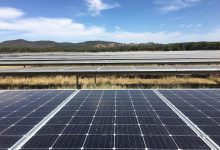Growing amounts of curtailment, spreading to new parts of congested electricity networks, have dented the value of Australia’s wind and solar projects, as investments in much-needed transmission infrastructure lag the pace at which generation capacity is added to the grid.
The troubles facing Australian wind and solar investors were outlined by ASX-listed New Energy Solar, which told investors on Tuesday that increases in the curtailment of solar output had complicated its exit from the Australian solar market.
Following a strategic review of its business, New Energy Solar decided to exit the Australian electricity market altogether, resolving to sell the Beryl and Manildra solar farms – both located in New South Wales – to focus its business on its more lucrative investments in the US-based solar projects.
Just 12 months ago, both solar farms had previously been identified as residing within a ‘sweet spot’ in the grid and at the time had largely avoided issues with loss factors and curtailment that had slashed revenues of other solar farms.
But in a half-year results briefing on Tuesday, New Energy Solar said that the sale of its two Australian solar farms had been impacted by ongoing challenges relating to curtailment, triggered by growing congestion in parts of the grid.
New Energy Solar’s CEO Liam Thomas said a flood of new projects had resulted in curtailment challenges spreading to other parts of the grid and cut the output of the Manildra solar farm by 40 per cent just as the company was looking for a buyer.
As a result, New Energy Solar said that it had forced to accept a lower than anticipated price for the Manildra solar farm from ultimate buyer Banpu Energy.
“The sale process was conducted through the early part of this year and while there was considerable interest from a range of buyers, the transmission problems in New South Wales emerged largely in the first quarter,” Thomas told the investor briefing.
“When NEW acquired Manildra, and Beryl, they were in strong parts of the grid and the marginal loss factors which reflect the project’s position in the electrical system relative to other generation have remained favourable.
“However, while the New South Wales government has set out to actively encourage new renewable generation in the system, the nature and location of this new generation is largely unregulated and there has been significant build of new solar throughout the state.”
“This is placed pressure on the largely existing grid infrastructure. One of the only tools available to to manage transmission congestion and overloading as it emerges day to day has been to curtail generation congested areas.
These issues can be resolved with investment in transmission and distribution, but that process is a lengthy one.”
“During the sale period, Manildra was regularly curtailed, and while we were able to improve Manildra ability to dispatch power over this period, these circumstances were challenging for some potential acquirers to evaluate and factor into their bids,” Thomas added.
Thomas contrasted the company’s experience in Australia with that of the company’s US-based projects, where utilities were required to compensate generators subject to curtailment for lost output. New Energy Solar said that it had faced such curtailment challenges at a Californian solar farm, for which it was compensated.
“Under the PPA with Southern California Edison for [Mount Signal 2] output, the utility is entitled to manage output through curtailment as part of its electricity supply and demand management,” Thomas said.
“Importantly, over and above the contracted level of curtailment, Southern California Edison must compensate NEW, unlike the experience of curtailment in Australia.”
Generally, no such compensation is payable to Australian generators when curtailment is imposed on them by the Australian Energy Market Operator.
New Energy Solar recorded a $35.1 million after-tax loss, which primarily reflected further write-downs to the book value of its solar farms due to falling forward wholesale electricity prices. The ASX-listed company now manages a portfolio of 14 solar farms, all of which are located in the United States.










